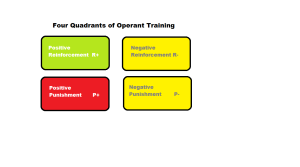
I know you have all heard the terms before i.e. positive/negative reinforcement and positive/negative punishment but what do they mean? When you are looking for a trainer and they tell you they use positive reinforcement methods do you find yourself scratching your head wondering what that means exactly? Hopefully this article will make it more understandable.
One thing to keep in mind is to remember no matter which one of the four quadrants we are talking about when we refer to “positive” techniques we are “adding” something and when we refer to “negative” techniques we are “removing” something. Also, when we are referring to “reinforcement” we are doing something that will increase the likelihood the behavior will occur again. If we are referring to “punishment” we are doing something that will decrease the likelihood a behavior will occur again.
Now let’s take a look at what each quadrant means.
Positive Reinforcement means we are adding something that will cause the animal to want to increase the likelihood the behavior will occur again. For example: By giving your dog a treat when he sits you will increase the likelihood he will do the same behavior (sit) the next time.
Negative Reinforcement means that you are removing something the animal doesn’t like in order to increase the likelihood the behavior will occur again. For example: Using a shaker can full of pennies (or any sound) to make a sound while the dog is barking and then removing the sound when the dog is quiet decreases the likelihood the behavior will occur again.
Positive Punishment means you are adding something the animal doesn’t like in order to increase the likelihood the behavior will occur again. For example: Hitting a rolled up newspaper on your hand to make a sound as soon as the dog barks you decrease the likelihood the dog will bark again.
Negative Punishment means you are taking away or removing something the dog wants in order to decrease the likelihood that the behavior will occur again. For example: Turning your back on and ignoring your dog for jumping up on you will decrease the likelihood that behavior will occur again.
Still confused? Don’t worry you’re not alone! It takes some time to get used to the various terms and how they are applied to the training you are doing. There are still numerous trainers out there that don’t fully understand the correct way to apply these terms. Many trainers say they ONLY use “positive reinforcement” training. As nice as this sounds, in the majority of cases this is simply not true. That doesn’t mean they aren’t good trainers or using the right protocols in their class it just means they don’t fully understand the definitions of the training. When one trainer told me they use 100% positive reinforcement methods only I asked what they did when a dog jumped up to greet them. They responded that they turn their back to them and ignore. There you go! That would be considered negative punishment so they could not be using 100% positive reinforcement methods. It is almost impossible to do.
Summary of Four Quadrants of Training
We hope this article helps to explain some of the terminology surrounding this confusing topic. Future articles will continue discussing various dog training techniques with insightful tips and techniques.
Our contributing writer Tracey Burns is WOOF Now What specialist in dog training. If you have specific questions we would be happy to answer them.
Photo Credit: Flickr Commercial use - Carterse - Evelyn's Graduation



